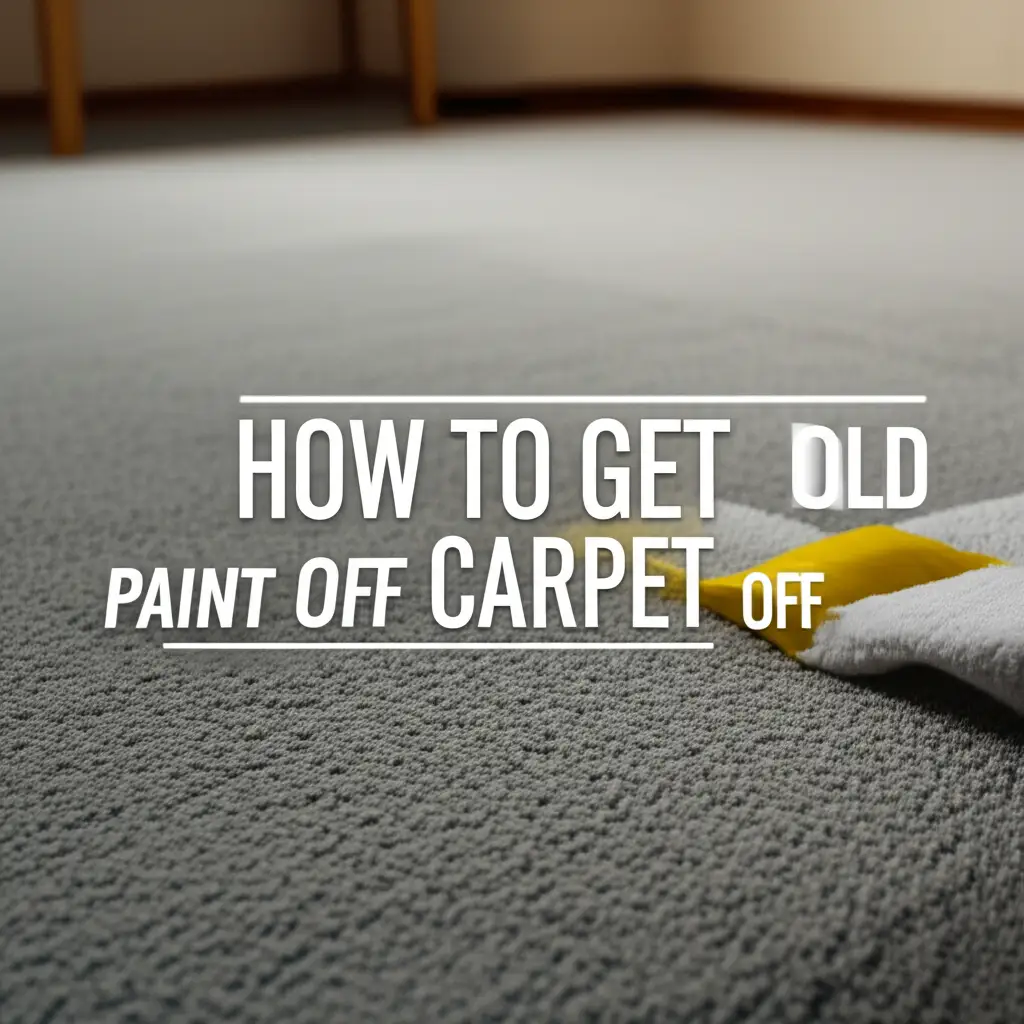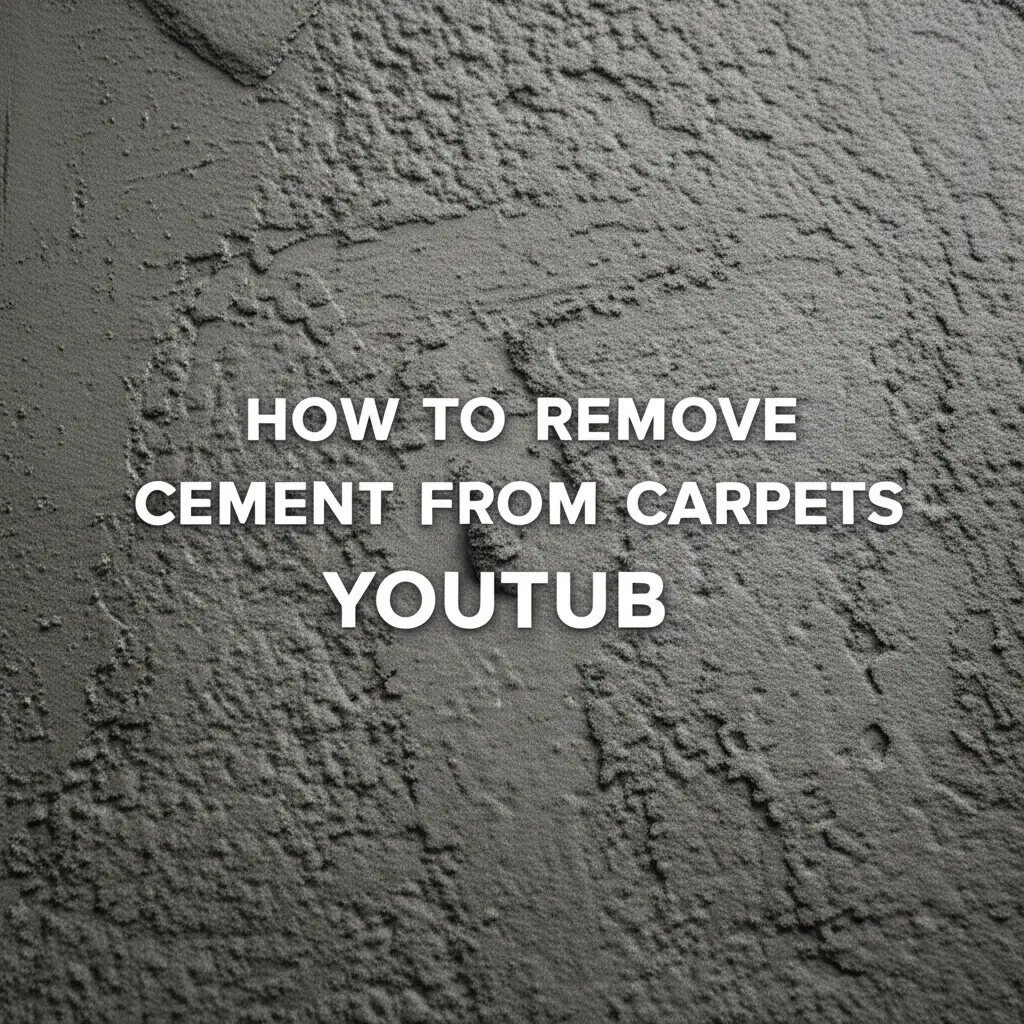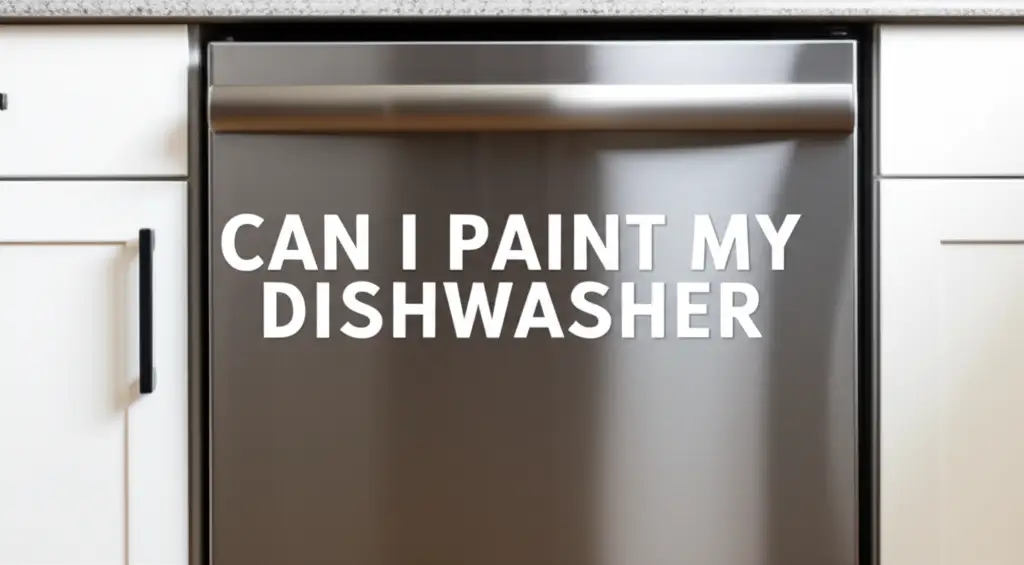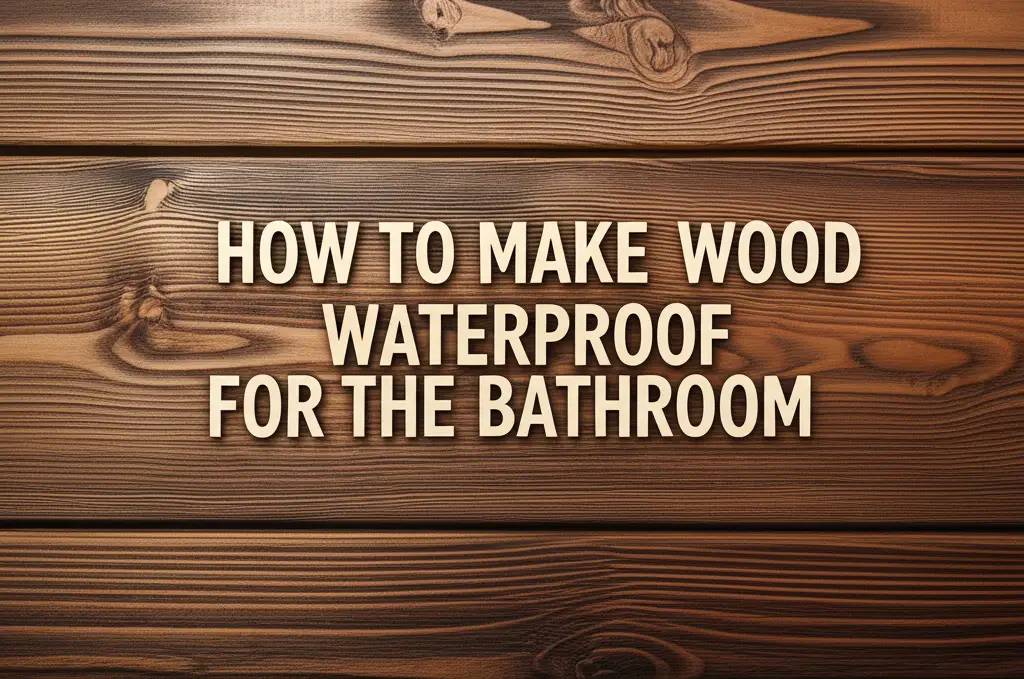· Tessa Winslow · Home Improvement · 22 min read
How To Get Old Paint Off Carpet

How To Get Old Paint Off Carpet: Your Ultimate Guide
A splash of paint on your carpet can feel like a disaster. When that paint dries and becomes old, the challenge grows even bigger. Many people think removing old paint from carpet is impossible. I understand this frustration. I have faced similar situations myself. However, restoring your carpet is often achievable. You can make your carpet look clean again with the right approach.
This comprehensive guide shows you how to get old paint off carpet. We cover everything from identifying the paint type to choosing the right tools. You will learn specific methods for different paint stains. We also discuss natural remedies and when to seek professional help. By the end, you will have the knowledge to tackle stubborn paint spots. Let us bring your carpet back to life.
Takeaway:
- Identify the paint type (water-based, oil-based, acrylic, spray) before starting.
- Gather necessary tools like a blunt knife, cloths, and appropriate cleaning solutions.
- Always test any cleaning solution on an inconspicuous area of your carpet first.
- Scrape off dried paint gently before applying any liquids.
- Blot, do not rub, to lift paint from the carpet fibers.
To get old paint off carpet, first identify the paint type and carpet material. Gently scrape away dried excess. Then, apply a suitable solvent or cleaning solution, like rubbing alcohol for latex or mineral spirits for oil-based paint, blotting the stain until it lifts. Always test a small hidden area first.
Understanding Your Foe: Types of Paint and Carpet Fibers
Removing old paint off carpet starts with understanding what you are up against. Paint is not just paint. Different types of paint require different removal strategies. Your carpet’s material also plays a role in how it reacts to cleaning solutions. I always begin by assessing these factors. This initial step saves time and prevents potential damage.
Knowing your paint and carpet helps you choose the safest and most effective method. Using the wrong product can set the stain permanently. It might even damage your carpet fibers. Let us look at the common types of paint and carpet materials you might encounter.
Common Paint Types
Each paint type has unique chemical properties. These properties determine the best way to dissolve or break down the dried stain.
Latex/Water-Based Paint
This is the most common type of household paint. It cleans up with water when wet. Once dry, it forms a plastic-like film. This film makes it more resistant to water. However, it is still the easiest dried paint to remove from carpet. Water-based paints include many interior wall paints. They are popular for their low odor and easy cleanup.
Oil-Based Paint
Oil-based paints are more durable and provide a harder finish. They do not clean up with water. They require solvents like mineral spirits or paint thinner. Old oil-based paint stains are tough. They bond strongly with carpet fibers. This type of paint is often used for trim, doors, or outdoor surfaces. It dries slower but forms a very resilient bond.
Acrylic Paint
Acrylic paint is water-soluble when wet. It becomes water-resistant when dry. It is a popular choice for art projects and crafting. Dried acrylic paint can behave similarly to latex paint. However, it often has a stronger polymer base. This base can make it slightly harder to remove once old and dry. Specific solvents are sometimes needed for complete removal. If you are dealing with this type, you might find our guide on how to get apple barrel paint out of carpet helpful. Another related resource is does acrylic paint come out of carpet, which offers specific insights into removing acrylic paints.
Spray Paint
Spray paint uses propellants and often contains strong solvents. It dries very quickly. Once dry, it forms a tough, durable layer. Removing old spray paint from carpet is challenging. It requires strong solvents like acetone or lacquer thinner. The fine mist of spray paint can penetrate deep into carpet fibers. This makes thorough removal difficult without the right tools.
Understanding Carpet Fiber Types
The material of your carpet affects how it tolerates cleaning solutions. Some fibers are more delicate than others.
Synthetic Fibers (Nylon, Polyester, Olefin)
Most modern carpets are made from synthetic fibers. These fibers are durable and stain-resistant. They generally handle mild solvents well. Nylon is particularly resilient. Polyester and olefin are good at resisting water-based stains. They can be more sensitive to strong chemicals. Always test solutions on an unseen area first.
Natural Fibers (Wool, Cotton, Silk)
Natural fiber carpets are luxurious but sensitive. Wool is highly absorbent and can shrink or discolor with harsh chemicals. Cotton and silk are also prone to damage. Using strong solvents on natural fibers can cause irreversible harm. I recommend starting with the gentlest method for these carpets. If unsure, consult a professional.
By knowing both the paint type and your carpet’s fiber, you can choose the most appropriate and safest removal method. This careful preparation is key to success. For a broader understanding of what common cleaning agents work on various paint types, consider reading what gets paint out of carpet.
Essential Tools and Materials You Will Need
Before you begin removing old paint off carpet, gather all your supplies. Having everything ready saves time and ensures a smooth process. You do not want to stop mid-task because you are missing something. I always lay out my tools before starting any cleaning project. This helps me stay organized and focused.
The tools and materials you need depend on the type of paint and the method you choose. However, some items are universally helpful. Others are specific to certain solutions. Make sure to choose high-quality materials. This improves effectiveness and prevents damage.
Basic Removal Tools
These items are useful for almost any paint removal task on carpet.
- Blunt Scraper or Spoon: A blunt edge helps chip away dried paint without damaging carpet fibers. A plastic putty knife or even an old credit card works well. Avoid sharp objects like knives.
- Stiff Brush or Old Toothbrush: These are useful for loosening paint particles. They help work cleaning solutions into the carpet pile. Choose a brush with firm but not abrasive bristles.
- Vacuum Cleaner: A vacuum removes loose paint chips and debris. It is essential for pre-treatment and post-treatment cleanup. Use an attachment for targeted cleaning.
- Clean White Cloths or Paper Towels: You will need many of these for blotting. White cloths prevent color transfer to your carpet. They also show how much paint you are lifting.
- Spray Bottle: A spray bottle allows for even application of liquid solutions. It prevents oversaturation of the carpet. This is important for preventing mold or damage to the carpet backing.
- Gloves: Protect your hands, especially when using chemical solvents. Disposable gloves are convenient.
- Bucket of Water: For rinsing cloths and diluting solutions. Having clean water readily available is important for cleanup.
Cleaning Solutions and Solvents
The specific cleaning agent depends on the paint type. Always purchase small amounts first.
For Water-Based (Latex) and Acrylic Paints:
- Warm Water: The first and gentlest approach for water-based paints.
- Liquid Dish Soap: A few drops mixed with warm water creates a mild cleaning solution. Dawn is a popular choice for its degreasing properties.
- Rubbing Alcohol (Isopropyl Alcohol): Effective for breaking down dried latex and acrylic paints. It evaporates quickly.
- Nail Polish Remover (Acetone-based): Acetone is a strong solvent. It can dissolve many types of paint, including acrylic. Be cautious with delicate fibers. Always check if the nail polish remover contains acetone, as non-acetone versions are less effective.
- Hair Spray: Contains alcohol and polymers that can help lift small, fresh paint spots. Less effective on old, dried stains.
- Glycerin: Can help soften very old, dried paint, making it easier to scrape off. It is a mild, non-toxic option.
For Oil-Based and Spray Paints:
- Mineral Spirits: A common solvent for oil-based paints. It is less harsh than paint thinner.
- Turpentine: Similar to mineral spirits, also effective for oil-based paints. Use in a well-ventilated area.
- Paint Thinner: Stronger than mineral spirits. Use with extreme caution and good ventilation.
- Acetone: Very strong solvent, effective on spray paint and some oil-based paints. Can damage synthetic carpet fibers like acetate or triacetate. Test carefully.
- Lacquer Thinner: Extremely strong. Only use as a last resort on very stubborn spray paint. Requires maximum ventilation and caution.
Safety Equipment
Safety is paramount when working with solvents.
- Good Ventilation: Open windows and doors. Use fans if necessary. Solvents produce fumes.
- Respirator Mask: Essential when using strong chemical solvents. Protects your lungs from harmful vapors.
- Eye Protection: Goggles protect your eyes from splashes.
By having all these tools and materials ready, you are prepared for the challenge. This preparation makes the old paint removal process safer and more efficient.
Step-by-Step Guide to Removing Dried Paint Stains
Once you have identified the paint type and gathered your supplies, you are ready to begin. Removing old paint off carpet requires patience and a methodical approach. Rushing the process can spread the stain or damage your carpet. I always advise working slowly and carefully. This method maximizes your chances of success.
Follow these steps for the best results. Remember to always test your cleaning solution first. This prevents irreversible damage to your carpet.
Step 1: Prepare the Area
Preparation is crucial for effective paint removal. It sets the stage for success.
- Ventilate: Open windows and turn on fans. This is especially important if you plan to use chemical solvents. Good airflow disperses fumes and keeps the air fresh.
- Remove Loose Debris: Vacuum the area around the paint stain. This removes dirt, dust, and any loose paint flakes. A clean surface helps the cleaning solution work better.
- Protect Surrounding Areas: Place old towels or plastic sheeting around the stain. This protects areas of the carpet that are not stained. It also prevents the cleaning solution from spreading.
Step 2: Gently Scrape Off Excess Paint
This is the first physical step in removing the dried paint. Be gentle to avoid damaging the carpet fibers.
- Use a Blunt Tool: Take a blunt knife, spoon, or plastic scraper.
- Scrape Carefully: Gently scrape off as much dried paint as possible. Work from the outside edges of the stain inward. This prevents spreading the paint further.
- Lift, Do Not Rub: The goal is to chip away the paint without pushing it deeper into the fibers. You will see small flakes of paint come off.
- Vacuum Up Loose Chips: Use your vacuum cleaner to pick up the scraped paint chips. This keeps the work area clean.
Step 3: Test Your Cleaning Solution
Never skip this step. It is the most important part of preventing damage.
- Choose an Inconspicuous Spot: Find a hidden area of your carpet. This could be inside a closet or under a piece of furniture.
- Apply a Small Amount: Apply a tiny amount of your chosen cleaning solution to this spot.
- Wait and Observe: Let it sit for 5-10 minutes. Check for any discoloration, fading, or damage to the carpet fibers.
- Blot Dry: Blot the area with a clean white cloth. If there is no negative reaction, proceed to the next step. If you see discoloration, try a different solution.
Step 4: Apply the Cleaning Solution
Now it is time to apply the solution directly to the old paint stain.
- Dampen a Cloth: Do not pour the solution directly onto the carpet. Instead, dampen a clean white cloth with your chosen cleaning solution.
- Blot the Stain: Gently blot the paint stain with the dampened cloth. Work from the outside edge of the stain towards the center. This helps prevent the stain from spreading.
- Avoid Rubbing: Rubbing can spread the paint and damage carpet fibers. Blotting lifts the paint.
- Apply Pressure: Apply light pressure as you blot. This helps the solution penetrate the dried paint.
- Repeat: Continue blotting with fresh sections of your cloth. You will see the paint transfer from the carpet to the cloth. Change to a new clean cloth as needed. The goal is to lift the paint, not just spread it around.
Step 5: Allow the Solution to Work
Patience is a virtue in paint removal. Let the solution do its job.
- Let it Sit: For stubborn stains, you may need to let the solution sit on the stain for a few minutes. Check the product instructions if using a commercial cleaner.
- Re-apply and Blot: If the stain is not lifting, re-dampen your cloth and continue blotting. You may need multiple applications.
Step 6: Rinse the Area
Rinsing removes residual cleaning solution and any remaining paint particles.
- Use Clean Water: Dampen a fresh, clean cloth with plain warm water.
- Blot to Rinse: Blot the treated area thoroughly with the water-dampened cloth. This removes the cleaning solution from the carpet fibers.
- Repeat Rinsing: Continue rinsing until you are sure all the cleaner is gone. Any residue can attract dirt later.
Step 7: Dry the Carpet
Proper drying prevents mold and mildew.
- Absorb Excess Moisture: Use clean, dry towels to blot up as much moisture as possible. Press down firmly to absorb water from the carpet pile.
- Air Dry: Allow the area to air dry completely. You can use fans to speed up the drying process. Do not walk on the damp area.
- Vacuum (Optional): Once dry, lightly vacuum the area. This helps restore the carpet’s texture.
Following these steps meticulously increases your chances of successful old paint removal. Be persistent; some stains require multiple attempts.
Specific Methods for Different Paint Types
Understanding the type of paint on your carpet is crucial. Each paint type responds best to specific cleaning agents. Using the wrong product can make the stain worse or damage your carpet. Here, I will detail the most effective methods for common dried paint types. I have personally used these approaches with success.
Removing Dried Latex or Water-Based Paint
Latex paint is often the easiest to remove, even when old. Its water-soluble nature helps.
- Start with Warm Water and Dish Soap: After scraping, dampen a clean white cloth with warm water. Add a drop or two of mild liquid dish soap to the cloth.
- Blot and Work: Gently blot the stain with the soapy cloth. Work from the outside in. The soap helps break down the dried paint film. Continue blotting, changing to clean parts of the cloth as paint transfers.
- Introduce Rubbing Alcohol: If soap and water are not enough, switch to rubbing alcohol. Dampen a new cloth with rubbing alcohol. Blot the stain, allowing the alcohol to break down the latex polymers.
- Use Nail Polish Remover (Acetone): For very stubborn latex, acetone can be effective. Apply a small amount to a clean cloth. Blot the stain. Be very careful with synthetic carpets as acetone can dissolve some fibers. Test first.
- Glycerin for Softening: For very old, hardened latex paint, apply a small amount of glycerin. Let it sit for a few hours or overnight. This can soften the paint, making it easier to scrape and blot away with water and soap or alcohol.
Tackling Dried Oil-Based Paint
Oil-based paints are more challenging. They require solvents to break down their oil base.
- Mineral Spirits or Turpentine: These are your primary go-to solvents. Dampen a clean white cloth with mineral spirits or turpentine.
- Blot Methodically: Blot the stain firmly with the solvent-dampened cloth. The solvent will dissolve the oil in the paint. Change cloths frequently as paint transfers.
- Work in a Well-Ventilated Area: These solvents produce strong fumes. Ensure excellent ventilation to protect your lungs.
- Follow with Dish Soap: After the paint has lifted, blot the area with a cloth dampened with warm water and a little dish soap. This helps remove any solvent residue.
- Rinse Thoroughly: Finish by blotting with clean water to rinse all residues.
Getting Rid of Dried Acrylic Paint
Dried acrylic paint can be tricky. It is water-resistant once dry, but alcohol and acetone can help.
- Rubbing Alcohol First: Begin by dampening a cloth with rubbing alcohol. Blot the stain repeatedly. The alcohol works to soften and dissolve the acrylic polymers.
- Nail Polish Remover (Acetone): If alcohol is not fully effective, use an acetone-based nail polish remover. Apply to a clean cloth and blot the stain. Remember, acetone is strong and requires careful testing. As noted earlier, our article does acrylic paint come out of carpet provides more specific advice.
- Scraping After Softening: As the paint softens, gently scrape more off with your blunt tool. Continue alternating between applying the solvent and scraping.
- Rinse and Dry: Once the paint is gone, rinse the area with clean water and blot dry.
Removing Dried Spray Paint
Spray paint is notoriously difficult due to its strong bond and fine particles.
- Acetone or Lacquer Thinner: These are often the most effective, but also the strongest, solvents for spray paint. Dampen a small area of a clean cloth.
- Apply Very Carefully: Blot the stain extremely carefully. These solvents can quickly dissolve synthetic fibers. Test an inconspicuous spot for at least 15 minutes.
- Work Small Sections: Work on very small sections of the stain at a time.
- Repeat Blotting and Scraping: As the paint dissolves, blot it up and gently scrape. Repeat this process until the stain is gone.
- Ventilation is Critical: Always ensure maximum ventilation when using these powerful solvents. Wear gloves and eye protection.
- Neutralize and Rinse: After removal, neutralize the area with a mild dish soap solution. Then, rinse thoroughly with clean water and dry.
Each paint type demands a specific attack plan. By matching the solvent to the paint, you increase your chances of successfully removing old paint off carpet without causing damage.
Natural and Less Harsh Solutions for Paint Removal
Sometimes, strong chemicals are not the first choice. You might have delicate carpet fibers. Or, you might prefer a more environmentally friendly approach. I often start with gentler methods when unsure about a carpet’s resilience. These natural solutions can be surprisingly effective on certain types of old paint. They are also safer for homes with children or pets.
While less aggressive, these methods still require patience and persistence. They might not work as quickly as strong solvents. However, they are a good starting point before resorting to harsher chemicals.
Dish Soap and Warm Water
This is the gentlest method and often effective for dried water-based or latex paints.
- Preparation: Scrape off as much dried paint as possible with a blunt tool.
- Create Solution: Mix a small amount of mild liquid dish soap (like Dawn) with warm water. Use a ratio of about one teaspoon of soap per cup of warm water.
- Apply and Blot: Dampen a clean white cloth with the soapy solution. Blot the paint stain gently. Work from the outside edge of the stain inward.
- Repeat and Rinse: Continue blotting, using fresh parts of the cloth as paint transfers. Rinse the area by blotting with a separate cloth dampened with plain warm water. This removes soap residue.
- Persistence: You may need to repeat this process many times for older, tougher stains. This method works by rehydrating the dried paint.
White Vinegar
Vinegar is a mild acid and a versatile household cleaner. It can help loosen some dried paints, especially water-based ones.
- Preparation: Scrape off excess dried paint.
- Apply Vinegar: Pour a small amount of undiluted white vinegar onto a clean white cloth.
- Blot the Stain: Blot the paint stain with the vinegar-soaked cloth. Let the vinegar sit on the stain for a few minutes. The acid helps break down the paint’s bond.
- Brush Gently: Use a stiff brush or old toothbrush to gently scrub the stain. This helps lift the softened paint.
- Rinse: Rinse the area by blotting with a clean cloth dampened with plain water. You might notice a vinegar smell, which will dissipate as it dries.
Glycerin
Glycerin is a humectant, meaning it attracts and retains moisture. This property can help soften very old, hardened paint stains.
- Apply Glycerin: Apply a small amount of pure glycerin directly onto the old paint stain. You can find glycerin in drugstores.
- Let It Sit: Allow the glycerin to sit on the stain for several hours, or even overnight. It needs time to penetrate and soften the dried paint.
- Scrape and Clean: After the soaking period, gently scrape off any softened paint. Then, proceed with the dish soap and water method to remove the remaining paint and glycerin residue. The softened paint should be much easier to lift.
Hair Spray
Some hair sprays contain alcohol and polymers that can dissolve certain types of paint. This works best for small, recent spots, but it can be worth a try on old stains.
- Spray and Blot: Spray a small amount of hair spray directly onto the old paint stain. Do not oversaturate the carpet.
- Immediate Blotting: Immediately blot the area with a clean white cloth. The alcohol helps dissolve the paint.
- Repeat Quickly: Repeat the process if needed, working quickly before the hair spray dries.
- Rinse: Rinse the area with a damp cloth and plain water after the paint is removed.
While these natural methods require more time and effort, they are a safer alternative for removing old paint off carpet, especially on delicate or sensitive carpet materials. Always remember to test first.
When to Call a Professional: Knowing Your Limits
Sometimes, despite your best efforts, the old paint stain remains stubborn. Or, you might face a stain that seems too large or complex to tackle yourself. Knowing when to call a professional carpet cleaner is important. Attempting to remove a stain beyond your capabilities can lead to permanent damage to your carpet. I have seen situations where DIY attempts made the stain worse.
Professional carpet cleaners have specialized equipment, industrial-strength solvents, and extensive experience. They can often achieve results that are impossible with home methods.
When to Consider Professional Help
There are several scenarios where professional intervention is advisable:
- Very Large Stains: A small spot is manageable. A large splatter or spill covering a significant area is a much bigger project. Professionals have the tools to clean wide areas efficiently.
- Very Old, Deeply Embedded Stains: Paint that has been on the carpet for years can bond deeply with the fibers. It becomes incredibly difficult to remove without powerful solvents and specialized techniques.
- Delicate Carpet Materials: If your carpet is made of wool, silk, or a rare synthetic blend, strong DIY solvents can cause irreversible damage. Professionals understand fiber types and use appropriate, safe cleaning agents.
- Concerns About Discoloration or Damage: If you are worried about changing your carpet’s color or texture, a professional assessment is best. They can often guarantee their work.
- Failed DIY Attempts: If you have tried several methods and the stain remains, stop. Further attempts with different chemicals might create a chemical reaction. This could set the stain or damage the carpet beyond repair.
- Health and Safety Concerns: Using strong solvents requires good ventilation and protective gear. If you cannot ensure a safe environment, a professional is a safer choice.
- Unidentifiable Paint Type: If you do not know what kind of paint spilled, guessing can be risky. Professionals can often identify the paint type and choose the correct approach.
What a Professional Can Offer
Professional carpet cleaners bring several advantages to the table:
- Specialized Equipment: They use powerful hot water extraction units. These units penetrate deep into carpet fibers and rinse thoroughly. This removes paint and cleaning solution residue effectively.
- Industrial-Strength Solutions: They have access to commercial-grade solvents and cleaning agents. These are more effective than consumer products.
- Expert Knowledge: Professionals understand different carpet materials and paint types. They can assess the situation and choose the safest, most effective method.
- Experience: They have dealt with countless types of stains. Their experience allows them to tackle complex paint removal challenges.
- Stain Guarantee: Many reputable companies offer a guarantee on their stain removal services. This gives you peace of mind.
While the goal is often to save money with DIY, sometimes the cost of professional cleaning is less than replacing damaged carpet. Consider professional help as an investment in your carpet’s longevity and appearance. A general cleaning of your carpet can also improve its overall look, especially if it has been there for a long time. For more information, you might be interested in our article does cleaning 10 year old carpet work.
Prevention is Key: Protecting Your Carpet from Paint Spills
The best way to deal with old paint on carpet is to prevent it from happening. I learned this lesson early in my DIY journey. Accidents happen, but many paint spills are avoidable with proper preparation. Taking a few simple precautions can save you hours of cleaning and potential carpet replacement costs. Think of it as an investment in your peace of mind.
Here are essential tips to protect your carpet when painting. Implement these steps every time you work with paint.
1. Clear the Area Completely
Before you even open a paint can, remove everything from the room that you can.
- Furniture: Move all furniture out of the room. If furniture is too heavy to move, push it to the center of the room. Cover it thoroughly with plastic sheeting or old blankets.
- Small Items: Remove rugs, decorative items, lamps, and anything else that could get paint on it.
2. Lay Down Drop Cloths Extensively
This is your carpet’s primary defense. Do not skimp on coverage.
- Use Canvas Drop Cloths: Canvas drop cloths are superior to plastic. They are absorbent, preventing paint from pooling and seeping through. They also provide better grip, reducing slip hazards.
- Cover All Carpeted Areas: Lay drop cloths across the entire carpeted floor you are working on. Overlap them by several inches.
- Secure Edges: Tape the edges of the drop cloths to the baseboards with painter’s tape. This prevents them from shifting and exposing carpet. This is especially important near walls where spills are most likely.
- Layer Up: For extra protection, especially if you are prone to drips or using very thin paint, consider a second layer of drop cloths or plastic sheeting under the canvas.
To expand on this, understanding what can i put over carpet to protect it provides even more ideas for robust protection.
3. Tape Off Edges and Baseboards
Painter’s tape creates a clean line and protects adjacent surfaces.
- Apply Painter’s Tape: Use high-quality painter’s tape along the baseboards where the carpet meets the wall. Press it down firmly to create a seal.
- Cover Molding: If painting trim or molding, extend the tape onto the carpet edge beneath it.
4. Use Proper Painting Techniques
Your painting technique also plays a role in preventing spills.
- Don’t Overload Your Brush/Roller: Dip only the tip of your brush or roller into the paint. Too much paint leads to drips and splatters.
- Scrape Excess Paint: Scrape excess paint off your brush on the edge of the can. Roll excess paint off your roller on the tray grid.
- Work Slowly and Deliberately: Rushing increases the chance of accidents. Take your time, especially near edges and corners.
- Keep a Wet Rag Handy: Have a damp cloth or paper towels nearby. Wipe up any small drips immediately before they dry.





